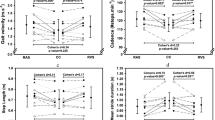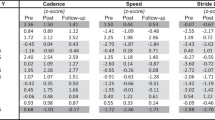Abstract
This study has focused on how sensory stimulation affects gait in Parkinson’s disease (PD). The kinematic parameters of gait [cadence, step amplitude, velocity, coefficient of variation of stride time (CVstride-time), and the coefficient of variation of the step amplitude (CVstep-amplitude)] were analysed in 25 PD patients and 10 control subjects. Step amplitude, velocity and CVstride-time were altered in the patients with PD. However, when kinematic parameters were analysed as a function of disease severity, none of the parameters differed between early PD (I–II Hoehn and Yahr) and the controls. Nevertheless, more severely affected PD patients (III–IV Hoehn and Yahr) walked with a reduced step amplitude, lower velocity, higher CVstride-time, and higher CVstep-amplitude than the controls. The administration of auditory stimulation at a frequency matching the preferred walking cadence led to a decrease in the CVstride-time in PDIII–IV patients, and to an increase in step amplitude in PDIII–IV and controls. Visual stimulation at the same frequency did not modify any of the altered kinematic parameters in PDIII–IV patients. When different stimulation frequencies were utilised, auditory stimulation significantly changed some of the altered walking parameters in Parkinson patients. Frequencies matching preferred walking cadence or above this, up to the fastest walking, were those that seem to interact most effectively with the abnormal kinematic parameters in PDIII–IV patients. Visual stimulation negatively modulated cadence in PDIII–IV in the frequency range used. Sensory stimulation facilitates gait in PD. Studies using sensory stimulation as a tool to facilitate walking should take into account the grade of disability of the patients.

Similar content being viewed by others
References
Azulay JP, Mesure S, Amblard B, Blin O, Sangla I, Pouget J (1999) Visual control of locomotion in Parkinson’s disease. Brain 122:111–120
Blin O, Ferrandez AM, Serratrice G (1990) Quantitative analysis of gait in Parkinson patients: increase variability of stride length. J Neurol Sci 98(1):91–97
Chen Y, Repp BH, Patel A (2002) Spectral decomposition of variability in synchronization and continuation tapping: comparison between auditory and visual pacing feedback conditions. Hum Mov Sci 21:515–532
Ebersbach G, Heijmenberg M, Kindermann L, Trottenberg T, Wissel J, Poewe W (1999) Interference of rhythmic constraint on gait in healthy subjects and patients with early Parkinson’s disease: evidence for impaired locomotor pattern generation in early Parkinson’s disease. Mov Disord 14(4):619–625
Enzensberger W, Fischer PA (1996) Metronome in Parkinson’s disease. Lancet 347:133
Fahn S, Elton RL (1987) Unified Parkinson’s disease rating scale. In: Fahn S, Marsden CD, Calne D, Goldstein M (eds) Recent developments in Parkinson’s disease. Macmillan, Florham Park, pp 153–163
Fernández del Olmo M, Cudeiro J (2005) Temporal variability of gait in PD. Effects of a rehabilitation programme based on rhythmic sound cues. Parkinsonism Relat Disord 11:25–33
Fernández del Olmo M, Arias P, Furio MC, Pozo MA, Cudeiro J (2006) Evaluation of the effect of training using auditory stimulation on rhythmic movement in Parkinsonian patients—a combined motor and [18F]-FDG PET study. Parkinsonism Relat Disord 12:154–164
Freedland RL, Festa C, Sealy M, McBean A, Elghazaly P, Capan A, Brozycki L, Nelson AJ, Rothman J (2002) The effects of pulsed auditory stimulation on various gait measurements in persons with Parkinson’s disease. NeuroRehabilitation 17:81–87
Frenkel-Toledo S, Giladi N, Peretz C, Herman T, Gruendlinger L, Hausdorff JM (2005) Effect of gait speed on gait rhythmicity in Parkinson’s disease: variability of stride time and swing time respond differently. J NeuroEng Rehabil 2:23–29
Goetz CG, Poewe W, Rascol O, Sampaio C, Stebbins GT, Counsell C, Giladi N, Holloway RG, Moore CG, Wenning GK, Yahr MD, Seidl L (2004) Movement Disorder Society Task Force report on the Hoehn and Yahr staging scale: status and recommendations. Mov Disord 19(9):1020–1028
Goldberg G (1985) Supplementary motor area structure and function: review and hypotheses. Behav Brain Res 8:567–588
Hausdorff JM, Cudkowicz ME, Firtion R, Wei JY, Goldberger AL (1998) Gait variability and basal ganglia disorders: stride-to-stride variations of gait cycle timing in Parkinson’s disease and Huntington’s disease. Mov Disord 13(3):428–437
Hoehn MM, Yahr MD (1967) Parkinsonism: onset, progression, and mortality. Neurology 17:427–42
Howe TE, Lovgreen B, Cody FW, Ashton VJ, Oldham JA (2003) Auditory cues can modify the gait of persons with early-stage Parkinon’s disease: a method for enhancing parkinsonian walking performance? Clin Rehabil 17(4):363–367
Kokmen E, Naessens JM, Offord KP (1987) A short test of mental status: description and preliminary results. Mayo Clin Proc 62:281–288
Lewis GN, Byblow WD, Walt SE (2000) Stride length regulation in Parkinson’s disease: the use of extrinsic, visual cues. Brain 123:2077–2090
Marchese R, Diverio M, Zucchi F, Lentino C, Abbruzzese G (2000) The role of sensory cues in the rehabilitation of parkinsonian patients: a comparison of two physical therapy protocols. Mov Disord 15(5):879–883
McIntosh GC, Brown SH, Rice RR, Thaut MH (1997) Rhythmic auditorymotor facilitation of gait patterns in patients with Parkinson’s disease. J Neurol Neurosurg Psychiatry 62:22–26
Miller RA, Thaut MH, McIntosh GC, Rice RR (1996) Components of EMG symmetry and variability in parkinsonian and healthy elderly gait. Electroencephalogr Clin Neurophysiol 101:1–7
Morris M, Iansek R, Matyas TA, Summers JJ (1998) Abnormalities in the stride length-cadence relation in Parkinsonian gait. Mov Disord 13:61–69
Morris M, Iansek R, McGinley J, Matyas T, Huxham F (2005) Three-dimensional gait biomechanics in Parkinson’s disease: evidence for centrally mediated amplitude regulation disorder. Mov Disord 20(1):40–50
Morris ME, Iansek R, Matyas TA, Summers JJ (1994a) Ability to modulate walking cadence remains intact in Parkinson’s disease. J Neurol Neurosurg Psychiatry 57:1532–1534
Morris ME, Iansek R, Matyas TA, Summers JJ (1994b) The pathogenesis of gait hypokinesia in Parkinson’s disease. Brain 117:1169–1181
Morris ME, Iansek R, Matyas TA, Summers JJ (1996) Stride length regulation in Parkinson’s disease. Normalization strategies and underlying mechanisms. Brain 119:551–568
Nieuwboer A, Kwakkel G, Rochester L, Jones D, van Wegen E, Willems AM, Chavret F, Hetherington V, Baker K, Lim I (2007) Cueing training in the home improves gait-related mobility in Parkinson’s disease: the RESCUE trial. J Neurol Neurosurg Psychiatry 78:134–140
Rochester L, Hetherington V, Jones D, Nieuwboer A, Willems AM, Kwakkel G, Van Wegen E (2005) The effect of external rhythmic cues (auditory and visual) on walking during a functional task in homes of people with Parkinson’s disease. Arch Phys Med Rehabil 86:999–1006
Rossignol S, Melvill-Jones G (1976) Audiospinal influences in man studied by the H-reflex and its possible role in rhythmic movement synchronized to sound. Electroencephalogr Clin Neurophysiol 41:83–92
Schaafsma JD, Giladi N, Balash Y, Bartels AL, Gurevich T, Hausdorff JM (2003) Gait dynamics in Parkinson’s disease: relationship to Parkinsonian features, falls and response to levodopa. J Neurol Sci 212:47–53
Schwab RS, England AC (1969) Projection technique for evaluating surgery in Parkinson’s disease. In: Gillingham FJ, Donaldson IML (eds) Third symposium on Parkinson’s disease. Livingstone, Edinburgh, pp 152–157
Suteerawattananon M, Morris GS, Etnyre BR, Jankovic J, Protas EJ (2004) Effect of visual and auditory cues on gait in individuals with Parkinson’s disease. J Neurol Sci 219:63–69
Thaut MH, McIntosh GC, Rice RR, Miller RA, Rathbun J, Brault JM (1996) Rhythmic auditory stimulation in gait training for Parkinson’s Disease patients. Mov Disord 11(2):193–200
Willems AM, Nieuwboer A, Chavret F, Desloovere K, Dom R, Rochester L, Jones D, Kwakkel G, Van Wegen E (2006) The use of rhythmic auditory cues to influence gait in patients with Parkinson’s disease, the differential effect for freezers and non-freezers, an explorative study. Disabil Rehabil 28(11):721–728
Acknowledgments
We would like to thank K.L. Grieve for his comments and corrections on the manuscript, M. Fernandez del Olmo for his contribution to the work described here, and Salvador Naya and Ricardo Cao for their advice on statistical analysis. This study was supported by Xunta de Galicia (PGIDIT06PXIC137004PN and Consellería de Educación-2007/000140-0), Spain.
Author information
Authors and Affiliations
Corresponding author
Rights and permissions
About this article
Cite this article
Arias, P., Cudeiro, J. Effects of rhythmic sensory stimulation (auditory, visual) on gait in Parkinson’s disease patients. Exp Brain Res 186, 589–601 (2008). https://doi.org/10.1007/s00221-007-1263-y
Received:
Accepted:
Published:
Issue Date:
DOI: https://doi.org/10.1007/s00221-007-1263-y




